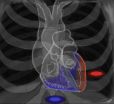(Press-News.org) ANN ARBOR, Mich. - Door-to-balloon time has dropped dramatically as hospitals rush heart attack patients into treatment, but a five-year study released Monday shows quicker hospital care has not saved more lives.
Heart attacks are a medical emergency and hospitals race against the clock to open the clogged artery causing the attack in 90 minutes or less.
Door-to-balloon time is the amount of time between a heart attack patient's arrival at the hospital to the time he or she receives an intervention, such as a balloon angioplasty, to open the artery.
The study published in the Archives of Internal Medicine showed no change in mortality, in spite of the drops in door-to-balloon time at Michigan hospitals from 113 minutes in 2003 to 76 minutes in 2008.
The U-M Cardiovascular Center and colleagues at Michigan hospitals tracked the outcomes of 8,771 patients with acute ST-elevation myocardial infarction, commonly known as a severe heart attack.
"Considerable effort has focused on reducing door-to-balloon time with the assumption that quicker care translates into a significant reduction in mortality," says study senior author Hitinder Gurm, M.D., an interventional cardiologist at the U-M Cardiovascular Center.
"When we looked at our data, the reduction in door-to-balloon time was dramatic. However, to our surprise and dismay, we found the number of patients who died had not changed," he says.
Deaths from these heart attacks remained at about 4 percent.
Current American Heart Association and American College of Cardiology guidelines recommend getting these patients into treatment in 90 minutes or less.
"Our results suggest that a successful implementation of efforts to reduce door-to-balloon time has not resulted in the expected survival benefit," says Anneliese Flynn, M.D., a resident in the U-M Department of Internal Medicine, and lead author of the trends study.
By the end of the study period, nearly 70 percent of Michigan patients received care in the recommended DTB time. The study examined whether patients did better because of it.
"We need to do a better job at educating patients and developing sytems of care so that patients get to the hospital quicker and not only worry about the time involved once they hit the hospital door," Gurm explains.
"To improve patient outcomes we need to focus on the entire event - from the moment a person experiences chest pain to the time they get treated," he says.
Although door-to-balloon time dropped, the study showed no improvement in the time between the onset of symptoms such as chest pain, and when patients arrived at the hospital.
"It could be that the negative impact of the increased symptom-to-door time among high risk patients is sufficient to mask any potential protective effect of the decreased door-to-balloon time," Flynn says.
The Cardiovascular Consortium, called BMC2, is a collaborative network of physicians and hospitals and involves 32 Michigan hospitals that performs percutaneous coronary intervention, such as angioplasty and stents to treat patients with coronary artery diseases.
BMC2 registry is a physician lead quality improvement collaborative that is supported by the Blue Cross Blue Shield of Michigan. The collaborative works to improve outcomes of patients undergoing PCI with a special focus on reducing complications, and improving safety, efficacy and appropriateness of procedures.
The University of Michigan has been the coordinating center for BMC2 since 1997.
###
To learn more about signs and symptoms of a heart attack
http://www.americanheart.org/presenter.jhtml?identifier=4595
Additional authors: Mauro Moscucci, M.D., MBA, Univerity of Miami, formerly of U-M; David Share, M.D., MPH, of U-M Department of Family Medicine, Dean Smith, Ph.D, MPH, of U-M Cardiovascular Center; Thomas LaLonde, M.D., of St. John Hospital and Medical Center, Hameem Changezi, M.D., of Genesys Regional Hospital, and Arthur Riba, M.D., of Oakwood Hospital and Medical Center.
Reference: "Trends in door-to-balloon time and mortality in patients with ST-elevation myocardial infarction undergoing primary percutaneous coronary intervention," Archives of Internal Medicine, Vol. 170, No. 20, Nov. 8, 2010
Funding: Blue Cross Blue Shield of Michigan.
Resources:
U-M Cardiovascular Center
www.umcvc.org
Blue Cross Blue Shield Cardiovascular Consortium (BMC2)
http://www.bmc2.org/
END
A new study shows how an amphibious fish stays alive for up to two months on land. It's all in the skin.
Mangrove killifish are small fish—only about an inch or two long—that live in temporary pools in the coastal mangrove forests of Central and South America and Florida. During dry seasons when their pools disappear, the fish hole up in leaf litter or hollow logs. As long as they stay moist, they can survive for extended periods out of water by breathing air through their skin. But oxygen isn't the only thing a fish out of water needs to worry about, according to Professor ...
Chapel Hill - A new discovery by UNC scientists describes how cells infected by the Epstein-Barr virus (EBV) produce small vesicles or sacs called exosomes, changing their cellular "cargo" of proteins and RNA. This altered exosome enters cells and can change the growth of recipient cells from benign to cancer-producing.
In this way, virus-infected cells can have wide-ranging effects and potentially manipulate other cells throughout the body. The findings are reported in the November 8, 2010 early online edition of the Proceedings of the National Academy of Sciences.
Nancy ...
University of Toronto scientists have found that chemicals used to line junk food wrappers and microwave popcorn bags are migrating into food and being ingested by people where they are contributing to chemical contamination observed in blood.
Perfluorinated carboxylic acids or PFCAs are the breakdown products of chemicals used to make non-stick and water- and stain-repellant products ranging from kitchen pans to clothing to food packaging. PFCAs, the best known of which is perfluorooctanoic acid (PFOA), are found in humans all around the world.
"We suspected that ...
The GOES-13 satellite is watching a flurry of activity in the Atlantic Ocean today as a cold front approaches the remnants of Hurricane Tomas and threatens to swallow it in the next couple of days.
Tomas is now a remnant low pressure area is located in the Atlantic near 26 North and 68 West hundreds of miles south-southwest of Bermuda and has a minimum central pressure of 994 millibars today, Nov. 8. A cold front off the U.S. East Coast however, is stalking Tomas' remnants and moving east threatening to swallow the former hurricane.
The Geostationary Operational Environmental ...
Jal was a tropical storm when it made landfall this weekend on the east coast of India and tracked across the country while weakening into a remnant low pressure area. NASA's Terra satellite captured an image of Jal's center as it was entering eastern India and NASA's Aqua satellite captured an infrared image as it was departing the country.
This weekend, Tropical Cyclone Jal made landfall in east central India and crossed the northern coast of Tamil Nadu and southern coast of Andhra Pradesh, north of Chennai. It dropped heavy rainfall and created some flooding. Gusty ...
CHICAGO --- Northwestern Medicine researchers at the Robert H. Lurie Comprehensive Cancer Center of Northwestern University have found that a new, nontoxic drug made from a chemical in soy could prevent the movement of cancer cells from the prostate to the rest of the body.
These findings will be presented at the Ninth Annual American Association for Cancer Research Frontiers in Cancer Prevention Research Conference.
Genistein, a natural chemical found in soy, is being used in the lab of Raymond Bergan, M.D., the director of experimental therapeutics at the Lurie Cancer ...
Saying goodbye to summer can be difficult for everybody. In some people the onset of winter triggers Seasonal Affective Disorder, or SAD, a mood disorder in which sufferers experience symptoms of depression. Happily, a special kind of gerbil exhibits remarkably similar reactions to SAD treatments as humans, opening a promising new channel for study and treatment of the common complaint.
With her work on the Israeli desert inhabitant gerbil called the Fat Sand Rat (Psammomys obesus), Prof. Noga Kronfeld-Schor of Tel Aviv University's Department of Zoology and her fellow ...
New techniques now being used at UCLA allow doctors to more precisely target certain areas of the heart to stop ventricular arrhythmias — serious abnormal rhythms in the heart's lower chambers — in high-risk patients.
Generally, arrhythmias can be controlled by medications, and sometimes defibrillators. But a potentially life-threatening, recurrent arrhythmia known as a ventricular tachycardia, which originates in one of the heart's two ventricles, can produce a fast heart beat that requires other interventions, such as catheter ablation, in which the precise focus ...
Children with learning difficulties can benefit from being encouraged to find their own way to solve arithmetic problems, according to new research from the University of Strathclyde in Glasgow, Scotland.
A study by Dr Lio Moscardini, in Strathclyde's Faculty of Humanities & Social Sciences, found that children deal better with arithmetical problems if they can use their own intuitive strategies such as using number blocks, drawings or breaking an equation up into smaller, simpler parts- rather than being instructed in arithmetical facts and procedures.
All the teachers ...
Irvine, Calif., Nov. 8, 2010 — A small amount of bleeding in the brain seems to be common among older individuals, according to a UC Irvine study.
Neurologist Dr. Mark Fisher and neuropathologist Dr. Ronald Kim found that cerebral microbleeds are highly prevalent in the aging brain – and not primarily products of stroke-related injury, hypertension or neurodegenerative diseases such as Alzheimer's, as had been thought.
"Prior work relied on brain imaging to show cerebral microbleeds," Fisher said. "But in this study, deep regions of the brain were closely examined under ...




